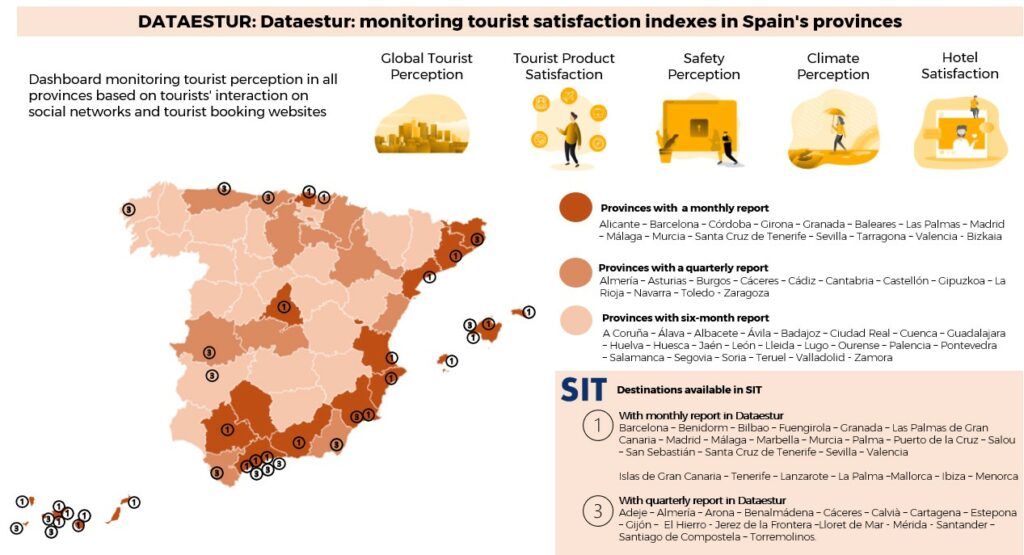Data to understand the degree of satisfaction of tourists with their destination

Monitoring tourist perception and satisfaction indices in Spain
- Dataestur monitors tourist satisfaction at the provincial level with an analytical visualisation of the data and the publication of periodic monitoring reports for all provinces and more than 20 tourist destinations.
- The SIT (Tourism Intelligence System) offers detailed visualisation for 40 tourist destinations.
The degree of tourist satisfaction is measured to provide an index to measure the tourist's perception of the destination and what it has on offer. These indexes are prepared with the interaction of tourists on social media and on tourist booking websites. Dataestur monitors five of these satisfaction indexes, which are prepared by Mabrian with information gathered with tourist activity on Twitter, Instagram, TripAdvisor, Booking and Expedia. These are the following indexes: global tourist perception, tourist product satisfaction, safety perception, climate perception and hotel satisfaction.

The Dataestur dashboard monitors indexes at the provincial level. Likewise, there is a section on monitoring by tourist destination in the regular reports, which can be downloaded, and in the dashboards available to tourist destination managers in the SIT (Tourist Information System).
Understanding de degree of tourist satisfaction at destinations with data
What is the degree of tourist satisfaction at my destination? Has it changed compared to last year? How has it changed throughout the year? These are the three initial questions that the Dataestur dashboards answers each month when monitoring tourists' perception of their experience in Spain. The data can be checked for each province and is based on the origin of the tourist or for the entire set of visitors.
What is the degree of tourist satisfaction at my destination? Has it changed compared to last year? How has it changed throughout the year? These are the three initial questions that the Dataestur dashboards answers each month when monitoring tourists' perception of their experience in Spain. The data can be checked for each province and is based on the origin of the tourist or for the entire set of visitors.
- Is the tourist experience at the destination positive? The closer the value obtained is to 100, the better it will be and the closer it gets to 0, the worse it becomes. As a reference, calculating the averages for all provinces can be a good indication.
- What are the trends in visitors' opinions? If you select the international variation filter in the lower graph of the "General" tab of the visualisation, you can see the trend for the last year at a glance. A good indicator is the improvement of the monthly value from the previous year. You can also check the annual trends in the "Month Analysis" tab of the last chart.
- Does seasonality and the number of tourists affect satisfaction? Initially, this can be verified by looking at the monthly evolution of the indices. We can identify some months in which the indexes have better or worse scores overall at a glance. In addition, Dataestur has numerous dashboards with relevant data for tourism analysis and the combination of this information with satisfaction indices can help identify possible correlations between tourist density and their perception of the experience.We take the cases of Malaga and Lleida as examples. In the case of Malaga, the dashboard shows that hotel satisfaction has declined slightly in July and August over the last two years. The chart shows its combination with the tourist arrival figures according to the INE's experimental statistics on measuring tourism using mobile telephone data and practically demonstrates a direct relationship between the concentration of tourists and hotel satisfaction. This increases when there is less influx and decreases when there are more tourists.
This analysis could be conducted with the available data, based on each source market or by analysing how it affects hotels according to their category.
In the case of Lleida, where the volume of tourists and their seasonality is lower than in Malaga, the relationship is less direct and is barely noticeable in the months with the most and least tourists: the degree of satisfaction is highest in November 2023, when fewer tourists arrive; and a spike in tourist arrivals in August 2024 causes a noticeable drop in hotel satisfaction.
The data available in Dataestur can also be used to compare satisfaction by source markets. The above two charts show the information for Lleida and refer to the degree of satisfaction of Spanish and French tourists (the two main markets of origin) with the hotels in Spain.
- Do tourists feel safe? One of the indexes monitored is the perception of safety and its values are often among the highest. In fact, the average value of all provinces is of around 89 with no changes and around 80% of the provinces obtain a value above 90.
- How do tourists rate the climate and how does the temperature or rainfall affect these ratings? One of the main reasons why tourists visit Spain is the weather. The Climate Perception Index reflects whether their experience responded to their expectations or not. When combined with other data, for example, temperature or rainfall, which is available in the Dataestur weather conditions dashboard, we can assess how changes in temperature or rainfall affect tourists' perception of the climate.In the case of Malaga, rainfall seems to be what causes the climate perception index to drop. It is especially clear in the rainiest months (March and October 2024). Regarding temperature, although the climate perception index during the warmer months is more positive, the mild winter barely affects the degree of satisfaction of tourists.
- Were there any changes in tourist perception during the celebration of a major event? The dashboard provides a weekly display of data that can be used to analyse the impact on satisfaction over short periods of time. You can check this in the "Week Analysis" tab and access the data for the week in which the event was held, compare it with the same week in other years or with the values for the same month and view the data by market of origin. Furthermore, it is recommended to take into account data from the weeks immediately following the event since the indexes are compiled based on tourists' interactions on the Internet and there may be a certain carry-over effect.The charts show how the overall tourist perception in the provinces of Seville and Navarre varied with the celebration of Easter Week and the Sanfermines this year.
- What are the most popular attractions in a destination? They can be consulted in the periodic reports published by Dataestur for more than 40 destinations and all provinces. The ten tourist attractions with the most user interactions on Twitter and Instagram are identified
- What are tourists most interested in during their visit? The monthly reports published by Dataestur show the percentage of interactions on social networks corresponding to the different types of tourism at destinations: sun and beach, sports and other similar activities, food and drink, culture, nature, family, nightlife, wellness and shopping.
- What is the age and nationality of the tourists who talk about the destination online? From the dashboard you can create a small profile of the tourists who give their opinion about the destination on social networks and on tourist booking websites. The "Monthly Analysis" tab shows a chart with the activity, classified by age range. The information is provided for tourists from each market, based on the volume of references. Therefore, we can identify the ages of the most active tourists in each market.
- In comparison to other destinations, what does the data of the destination reveal? Dataestur's analytical visualisation includes a "Comparative" tab. It can be used to compare the different indexes between provinces and according to the tourist's origin in a table and a chart.
Keep in mind that the SIT (Tourism Intelligence System) uses the same dashboard for 40 tourist destinations. They are aimed at destination managers and provide access to municipal information similar to the provincial information available from Dataestur.
Degree of tourist satisfaction at tourist destinations in Spain
The Dataestur dashboard provides information at the provincial level. From monthly indicator reports to active listening analysis reports published on the website, this information provides an overview of Spain with the average data of each province and for each index.
Therefore, the average values of each province are monitored for each index, as well as their year-on-year variations. A visual comparison of the indices of overall tourist perception and satisfaction with tourist products is also presented through a national map with provincial data.
You can also access additional information about hotels: percentage ratings in each market of origin and trends in the average prices per room for bookings in 3, 4 and 5-star hotels, booked one month in advance.

